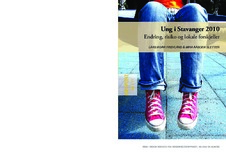| dc.description.abstract | This report is based on data from a local youth survey in the municipality of Stavanger. The study included 3112 students attending secondary schools in the municipality (mainly aged 13 to 16), which represents 68 percent of the target population. The data cover a wide range of subjects concerning young people’s everyday life. Relations to parents and peers, leisure activities, mental health issues, conduct problems, youth criminality, and substance use are given special attention in the report. Similar youth studies were conducted in Stavanger in 1994 and in 2002. Findings in the new study are compared to these earlier studies. The report also include analyses of differences between administrative districts in the municipality of Stavanger. Results Most young people in Stavanger are satisfied with their relations to parents and peers. Parents generally seem to have knowledge about what the adolescents do in their leisure time and who their friends are. Moreover, most young people in Stavanger have at least one good friend that they can trust and confide in. Boys, however, are slightly more likely than girls to report that they lack regular or close friends among their peers. Further, we have asked young inhabitants of Stavanger about their attitudes towards stereotyped youth groups. In general they express positive attitudes towards groups that in all likelihood would be preferred by their parents as well. Compared to the situation in 2002, young people in Stavanger express more positive attitudes towards homosexuality and immigrants. This is a continuing trend from 1994. Comparing young people’s leisure activities across survey points indicate that more time are spent in the family home and with computer-related activities. Boys in particular use a considerable amount of time on video games. However, young people in Stavanger watch slightly less television compared to the situation in 2002. The survey also indicates a drop in the share of young people who do paid work. In 1994 20 percent of 13–16 year olds held part time jobs, in 2002 17 percent marked off for the same, whereas only 10 percent do paid work at least two times a week in 2002. Even though relatively more of young people’s leisure time seems to be tied up in computer-related activities, the majority of secondary school students in Stavanger also participate in structured leisure activities. In total 79 percent take part in one or more leisure organizations, and the far most common organization type is athletic clubs (53 percent participation in an athletic club). Whereas the participation in different cultural activities seemed to have dropped from 1994 to 2002, a comparison between the 2002-survey and the 2010-survey show no such decrease. On the contrary, more young inhabitants in Stavanger report to have visited the cinema, been to a sports event or participated on a rock/pop concert in 2010 compared with the situation in 2002. Most 13–16 year olds have a positive self-image and are satisfied with their physical appearance. Still more than one out of four report sleeping problems, that they worry a lot in their everyday life or feel life to be overall toilsome. On average girls are more troubled with such thoughts than boys. Girls are also less satisfied with their bodies and have overall a more negative self-image than boys. Moreover, indicators of mental health problems are related to experiences with harassment or bullying from peers. In total 11 percent report that they are exposed to regular (at least monthly) harassment from peers at school or in their leisure time. Approximately as many has experienced «digital harassment» through mobiles or the Internet. The rate of conduct problems such as vandalism, truancy and having a violent argument with a teacher, show a decline compared with the situation in 1994 and 2002. Violation of the law is generally quit uncommon among young people in Stavanger. One exception exists; half of all 13 to 16-year-olds report to have copied or downloaded files from the internet illegally. More serious delinquent acts such as theft, threats and burglary are marginal incidents among young people in Stavanger, and the amount of such acts are neither particularly higher nor lower compared to the 2002-survey. The most marked change since the 2002-survey concerns substance use. While 78 percent of all secondary school students had tasted alcohol in 2002, the same holds for only 50 percent in 2010. Moreover, smoking both cigarettes and hash is less common in 2010. Additionally, the survey asked students to report if they thought they were able to get hold of hash in two to three days, if they wanted to. While 29 and 40 percent respectively ticked off positively for this in 1994 and in 2002, only 19 percent in the 2010-survey believe that they are able to get hold of hash within this time limit. | en |
| dc.description.abstract | I denne rapporten presenterer vi funn fra den kommunale Ungdata-undersøkelsen i Stavanger 2010, som er en oppfølging av to tidligere undersøkelser fra 1994 og 2002. Oppdragsgiver for rapporten er Stavanger kommune. I overkant av 3100 ungdomsskoleelever i kommunen har besvart undersøkelsen. Hensikten har vært å kartlegge hvordan stavangerungdom opplever sin hverdag, og på denne måten gi kommunen et verktøy for å kunne bedre oppvekstvilkårene for ungdom. Undersøkelsen dekker en rekke temaer knyttet til ungdoms hverdag, som familie, venner, skole, fritid, mental helse, deltakelse i antisosiale handlinger og rusmiddelbruk. Resultatene fra undersøkelsen viser at stavangerungdom i 2010 ser ut til å være «snillere» enn de var for både 8 og 16 år siden. Deltakelsen i ulike former for utagerende atferd har gått ned, og særlig det å drikke alkohol har blitt mindre vanlig. Samtidig brukes også noe mer av fritiden på voksenstyrte arenaer. | no_NB |
